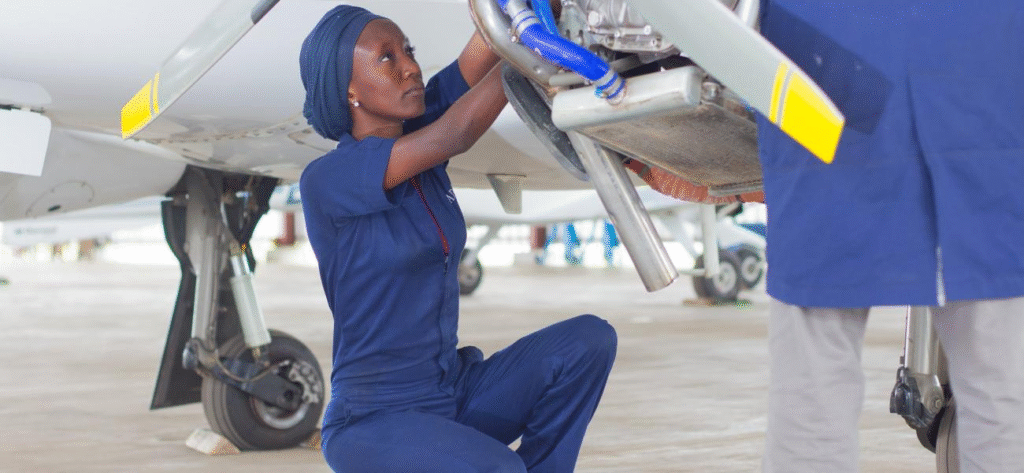The future of aviation in Africa is already taking shape, with transformative developments underway. In particular, Kenya is emerging as a pioneer in the field of Advanced Air Mobility (AAM) — an innovation that includes flying taxis and drone-based services — with the global AAM market expected to hit $1 trillion by 2040.
Rather than simply catching up with the rest of the world, AAM offers Africa a unique opportunity to leap ahead, overcoming long-standing transportation and infrastructure challenges while empowering the continent’s most abundant resource: its youth.

Nairobi Takes the Lead
This vision was on full display during the recent Advanced Air Mobility Symposium in Nairobi, where policymakers, entrepreneurs, engineers, and young innovators gathered to explore how Africa can become a leader in this new aviation frontier. Central themes included deploying electric vertical takeoff and landing aircraft (eVTOLs), integrating drones, and solving real-world problems like urban congestion and poor connectivity in rural regions.
To realize this future, Africa must strengthen infrastructure, develop supportive regulations, and — most critically — equip its youth with the skills needed to lead the charge.
Young People: The Heart of the Revolution
With over 60% of Africans under age 25, the continent has the world’s youngest population. By 2030, African youth will represent nearly 42% of the global youth demographic. For Captain Mercy Makau, founder of the Young Aviators Club of Africa (YACAfrica), AAM offers a once-in-a-generation chance to turn this demographic strength into real economic and technological progress.
Captain Makau emphasized that AAM aligns well with the UN Sustainable Development Goals and Africa Union’s Agenda 2063, particularly in areas like infrastructure, education, and employment. She believes that giving youth access to AAM-related opportunities will not only bridge development gaps but also strengthen national and continental resilience.
Building Tomorrow’s Aviation Leaders

Founded in 2012 and headquartered in Nairobi, YACAfrica now has more than 60,000 members between the ages of 4 and 27 from across Africa. The organization provides hands-on aviation experiences, mentorship programs, and STEM education to cultivate future professionals in aviation and aerospace.
YACA organizes its members into progressive mentorship tiers — Falcons (primary school), Eagles (high school), Hawks (university), and Albatross (young professionals) — creating a self-sustaining pipeline for aviation leadership.
Wesley Wafula, a YACA member, now volunteers as an aviation educator while awaiting university admission. He credits the club for nurturing his early interest in aviation and sees his teaching as a way to give back.
Martin Kariuki, a drone-certified aeronautical engineering student at the Technical University of Kenya (TUK), also lauded YACA for exposing him to broader aviation career paths beyond piloting, such as aviation law, medicine, and drone operations. He called on aviation companies and institutions to support youth with internships and funding for innovative projects.
Likewise, Everlyne Njuguna, another TUK student working toward her drone license, emphasized that youth are ready and eager to participate in AAM but need stronger engagement from industry stakeholders.
Youth-Driven Sustainability
While AAM has the potential to transform African mobility, concerns about environmental sustainability remain. Many eVTOLs use lithium-ion batteries, which pose ecological risks. Wakina Mutembei, Sustainability Lead at Kenya Airways, stressed the need to consider not just the deployment, but the full lifecycle of AAM technologies.
He highlighted the need for local assembly plants to spur job creation and questioned whether the materials used in eVTOLs can be recycled, reused, and maintained in ways that support sustainable development — especially with youth engagement in these processes.
Kimberly Nyawira, a student at TUK, proposed solar energy as a cleaner alternative to lithium batteries. Symposium participants also discussed the potential for hydrogen-powered eVTOLs, which offer lower emissions and easier recyclability.
Policy, Partnerships, and a Call to Action
Captain Makau underscored the importance of integrating youth perspectives into national aviation policy. YACA already collaborates with the Kenya Civil Aviation Authority (KCAA) through a capacity-building agreement and partners with ministries and universities on impactful projects like climate action and drone-powered precision agriculture.
These drones are used for environmental monitoring, deforestation tracking, wildlife conservation, and more — empowering youth with practical tools to support national development goals.
Looking ahead, YACA plans to host a major Aviation and Aerospace Forum in August, bringing together 3,000 young Africans to further discuss and shape the continent’s role in the AAM revolution.
The takeaway is clear: Africa’s youth are not just passive beneficiaries of technological progress — they are already active participants and future leaders. With the right investment in skills, resources, and institutional support, Africa’s young people can redefine the future of flight.


